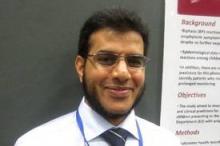SAN DIEGO – The more severe an anaphylactic reaction, the more likely that a child will have a second reaction within several hours, according to data from a review of more than 400 children. The findings were presented at the annual meeting of the American Academy of Allergy, Asthma, and Immunology.
Researchers found five independent predictors for biphasic reactions: age 6-9 years (OR, 3.60); time greater than 90 minutes from the onset of the initial anaphylactic reaction to emergency department presentation (OR, 2.58); wide pulse pressure at triage (OR, 2.92); treatment of the initial reaction with more than one dose of epinephrine (OR, 2.7); and administration of inhaled albuterol (Salbutamol) in the ED (OR, 2.39).
The "five clinical predictors could ultimately be used to identify patients who would benefit from prolonged ED or inpatient monitoring," noted Dr. Waleed D. Alqurashi of the University of Ottawa, and colleagues. "These findings may enable better utilization of ED resources and counseling of patients and families after anaphylactic reactions," they added.
The retrospective multicenter study included data from 484 children who visited an ED from January 2010 through December 2010 with anaphylactic reactions requiring epinephrine. Of these, 71 (15%) went on to a second reaction, most within 6 hours of the first. The median age of the children was 4.8 years, and about 65% were male.
"If any of these predictors are there, it means they need to be observed" at least 6-8 hours, said Dr. Alqurashi, an emergency medicine research fellow. "If the initial reaction was mild and treated appropriately with epinephrine, they don’t need to stay in the department for a long period of time," he said.
Of the 71 biphasic reactions, 53 (75%) occurred in the ED a median of 4.7 hours after the initial anaphylactic reaction; 18 (25%) occurred after ED discharge at a median of 18.5 hours from the first reaction. Thirty-five (49%) of the second reactions were anaphylactic, requiring epinephrine. "The other half were milder in nature," but still sometimes required oxygen or other significant interventions, Dr. Alqurashi said.
"Nobody knows exactly how often [biphasic reactions] happen," he said, although the data suggest that reactions occur about 15% of the time. The hunch is that the second reaction isn’t really an independent event, just a continuation of the first attack, he explained. "When you treat it the first time, you mask the symptoms" and the patient presents clinically again a few hours later, after the first round of medications wears off.
There were no statistical differences between children who had uniphasic and biphasic reactions in terms of the numbers of systems involved in their reactions. The majority of children in both groups had respiratory signs.
In agreement with previous studies, systemic steroids did not prevent biphasic reactions. "They were not useful. There may be a subpopulation that benefits from them, for example, people with asthma," Dr. Alqurashi said.
The investigators did not report outside funding. Dr. Alqurashi said he has no disclosures.


